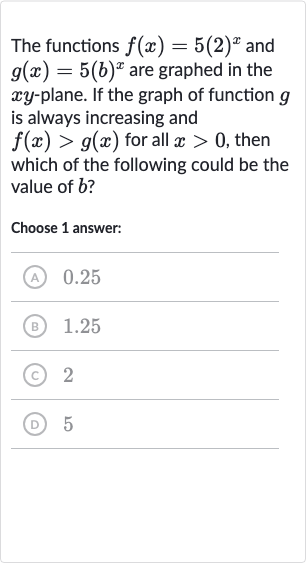Full solution
Q. The functions and are graphed in the -plane. If the graph of function is always increasing and for all , then which of the following could be the value of ?Choose answer:(A) .(B) .(C) (D)
- Analyze Functions: Analyze the given functions and conditions.We have two functions and . We are told that f(x) > g(x) for all x > 0, which means that for any positive , the value of is greater than the value of . Additionally, the graph of is always increasing, which implies that must be greater than because if were less than or equal to , the graph of would not be increasing.
- Compare Bases: Compare the bases of the exponential functions.Since and , and we know that f(x) > g(x) for all x > 0, the base of , which is , must be greater than the base of , which is . This means that must be less than .
- Combine Conditions: Combine the conditions to find the possible range for . From Step , we know that b > 1, and from Step , we know that b < 2. Therefore, the value of must be between and .
- Evaluate Choices: Evaluate the answer choices.We are given four options for the value of :(A) (B) (C) (D) From our previous steps, we know that must be greater than and less than . Therefore, the only option that fits this condition is (B) .
More problems from Compare linear and exponential growth
QuestionGet tutor help
QuestionGet tutor help
QuestionGet tutor help
QuestionGet tutor help
QuestionGet tutor help
QuestionGet tutor help
QuestionGet tutor help

